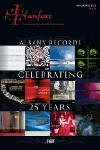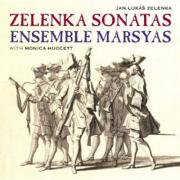Texte paru dans: / Appeared in: |
|
|
Reviewer: James
A. Altena It was the pioneering Archiv recordings from 1978 of Jan Dismas Zelenka’s trio sonatas and orchestral works, with an instrumental ensemble including the celebrated oboist Heinz Holliger, that put the composer’s name and music back into circulation after two centuries of obscurity. Since then the sonatas have become far and away Zelenka’s most recorded compositions, continuing to attract admirers for their inventive quirkiness. As three other Fanfare critics—John Bauman, Michael Carter, and Brian Robins—have ably discussed the music in extensive detail in their reviews of previous sets, I will refer readers to their discussions and focus upon a comparison of complete recordings in the original instrumentation for two oboes (with one replaced by a violin in the Third Sonata), bassoon, and continuo. (There have also been partial sets and recordings of arrangements made for string ensembles.) The aforementioned Archiv recording with Holliger either was not reviewed in these pages, or else any such review has not yet made its way into the online Archive; it is available as both a reissue in its original form from ArkivMusic.com and in a budget version from Brilliant Classics. Holliger made a second recording, for ECM in 1999, with some of the same instrumentalists as before; Robins praised that set in 23: 2 as well played but stated it was not to his taste, as he “simply cannot accept the thin, pinched sound of a pair of modern oboes in this music.” By contrast, Carter placed it in the Classical Hall of Fame in 26:4. In successive reviews in 17:5, 19:2, 19:4, and 19:5, Bauman praised both an MDG set with the Northwest German Chamber Soloists and a Claves set with members of the Chamber Orchestra of Europe, ranking them above the older Archiv set and dismissing a Berlin Classics set with oboist Burkhard Glaetzner with the comment that “these fine German musicians come as close to making Zelenka as dull as seems likely.” However, he endorsed as first choices an Accent set with a group of Belgian performers and two discs by Astrée with the Ensemble Zefiro as being “far and away the most exciting and imaginative we have had in the last several decades.” Robins also endorsed the Ensemble Zefiro as a first choice in his review of the ECM set. Contrary to Baumann, Carter had high praise for the Berlin Classics set in 30:1, ranking it as being virtually equal to the ECM release. There is one other set in print that has not been reviewed here, a Matous release from 1993 with a group of Czech musicians. For my part, I do not find myself in complete agreement with any of the above critics. For fans of Holliger, the ECM set is clearly superior to the old Archiv version: I agree with Robins and Carter on its merits, and unlike the former I do not object to hearing this music played on modern instruments, even though I do prefer period instruments for it. Unfortunately the Astrée discs and MDG set are both out of print. The few used copies of the former available through Amazon.com are advertised at obscene prices; those for the latter are more reasonable. Movements from some of the sonatas as played by Ensemble Zefiro are posted on YouTube; while handsomely played, I’m not as enthusiastic for them as either Bauman or Robins. The MDG set is solid, but I would prefer both the ECM and Astrée versions to it. I cannot concur with Bauman’s enthusiasm for the Accent set; it is a rare instance of a period ensemble engaging in stodgy, foursquare playing, and has an unnaturally reverberant recording acoustic. I agree with Bauman and disagree with Carter regarding the Berlin Classics recordings; they are indeed rather dull affairs, as is the Claves set. However, my endorsement would go to the hitherto neglected Matous release, which features elegant, vibrant, and heartfelt playing in a very attractive recorded acoustic. The fly in the ointment there is that it is the most expensive alternative, costing over $40.00, whereas the ECM set can be had far more cheaply. How does the present release compare with all of the preceding alternatives? Quite favorably; Ensemble Marsyas is a newly formed Scottish ensemble of baroque musicians, and this release marks an impressive recording debut. The performances are on period instruments, with the continuo parts variously played on violone, theorbo, harpsichord, and/or organ. Everyone blends well, and the tone colors are striking; I am particularly taken with bassoonist Peter Whelan, the ensemble’s founder, who offers by far the most pungent rendition of his part in any recording made of this music. Violinist Monica Huggett is, as one would expect, a most accomplished soloist in the Third Sonata, and the two oboists are quite agile. The booklet provides detailed and informative notes and several color photos. While I’m not convinced that SACD technology adds anything significant to a chamber ensemble beyond standard digital recording, the recorded sound is quite pleasing. My one point of hesitation is that I cannot find any indication as to whether a sequel disc is planned for the other three sonatas. If and when that appears, this would become the new set of choice. Until then, for a complete cycle go with ECM or Mantous, but do buy this now if you love these pieces and have the cash to spare; recommended. | |
|
|
|
|
|
|
|
Cliquez l'un ou l'autre
bouton pour découvrir bien d'autres critiques de CD |
|




